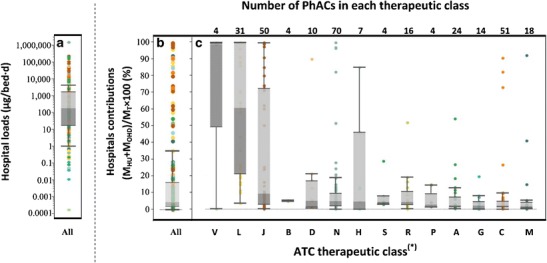Fig. 3.

Hospitals as a source of PhACs: a Net load of all 320 PhACs for which hospitals are significant sources; b Overall significance of hospitals as a source (M HU + M OHD) relative to the net environmental load (M T) of each PhAC for the 320 PhACs; c Significance of hospitals as a source of PhACs grouped according to therapeutic classes as defined by the Anatomical Therapeutic Chemical (ATC) Classification System. Colors are coordinated across all the three graphs and are indicative of therapeutic classes shown in (c). *Classifications according to the World Health Organization ATC classification system (47) where abbreviations used on the y-axis represent the following classes of drugs: A alimentary tract and metabolism; B blood and blood forming organs; C cardiovascular system; D dermatologicals, G genito-urinary system and sex hormones; H systemic hormonal preparations; J antiinfectives; L antineoplastic and immunomodulating agents; M musculo-skeletal system; N nervous system; P antiparasitic products; R respiratory system; S sensory organs; V various
